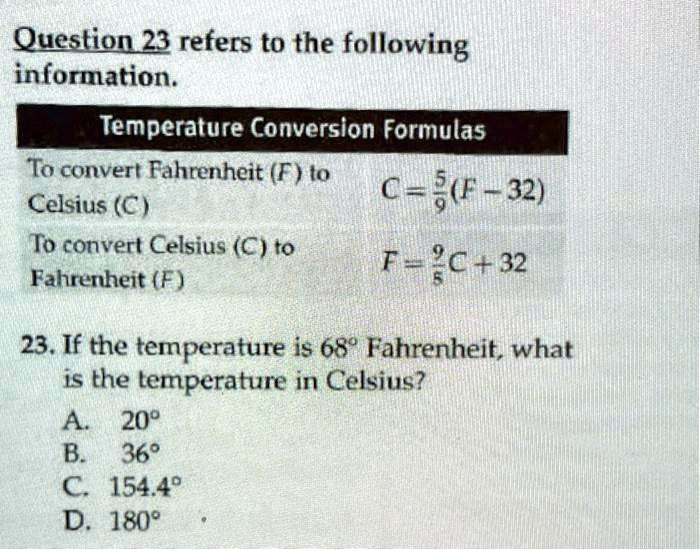Refers to the following information. Temperature Conversion Formulas To convert Fahrenheit (F) to Celsius (C) To convert Celsius (C) to Fahrenheit (F) 23. If the temperature is 68° Fahrenheit, what is the temperature in Celsius? A. 20° B. 36° C. 154.4° D. 180° C = \frac{5}{9}(F – 32) F = \frac{9}{5}C + 32

The Correct Answer and Explanation is:
To solve Question 23, we are asked to convert 68 degrees Fahrenheit to degrees Celsius using the provided formula:C=59(F−32)C = \frac{5}{9}(F – 32)C=95(F−32)
Step 1: Substitute the value of FFF
Given F=68F = 68F=68, we substitute into the formula:C=59(68−32)C = \frac{5}{9}(68 – 32)C=95(68−32)C=59(36)C = \frac{5}{9}(36)C=95(36)C=1809C = \frac{180}{9}C=9180C=20C = 20C=20
Correct Answer: A. 20°
Explanation
Temperature conversion between Fahrenheit and Celsius is a common necessity in science, travel, and international communication. The Fahrenheit scale is primarily used in the United States, while most of the world uses Celsius. The conversion formula from Fahrenheit to Celsius helps us translate temperatures from one system to the other accurately.
In this question, we use the formula:C=59(F−32)C = \frac{5}{9}(F – 32)C=95(F−32)
This equation subtracts 32 from the Fahrenheit value, which adjusts for the different starting points of the two scales. Fahrenheit zero is based on a saltwater freezing point, while Celsius zero is based on the freezing point of pure water. The factor 59\frac{5}{9}95 accounts for the difference in the size of the degree units. There are 180 Fahrenheit degrees between the freezing and boiling points of water, compared to 100 Celsius degrees. Thus, Fahrenheit degrees are smaller, and this ratio adjusts for that.
By applying this formula to 68 degrees Fahrenheit, we calculate:C=59(68−32)=59(36)=20C = \frac{5}{9}(68 – 32) = \frac{5}{9}(36) = 20C=95(68−32)=95(36)=20
So, 68 degrees Fahrenheit is equal to 20 degrees Celsius. Among the answer choices provided (20°, 36°, 154.4°, 180°), only option A is correct.
This simple calculation demonstrates the usefulness of knowing the conversion formula and highlights the practical application of algebraic manipulation in everyday contexts.
